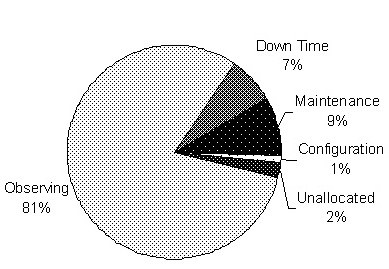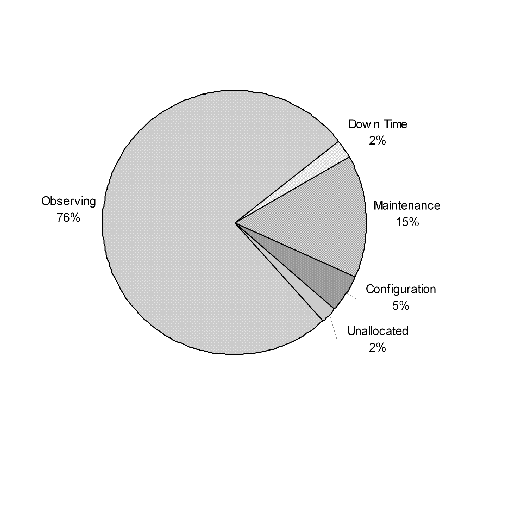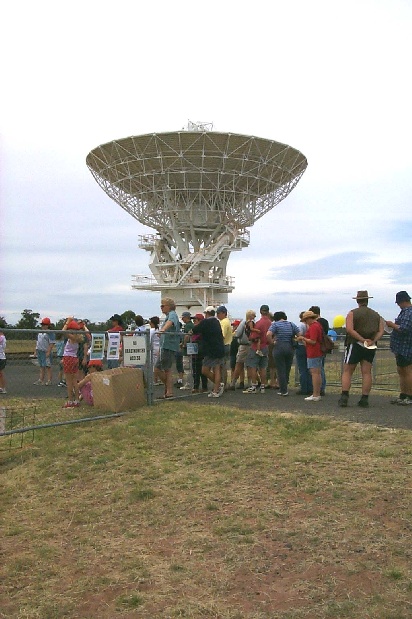Australia Telescope Compact Array report
STAFF
Graham Baines departed from the Observatory at the end of June after more than seven years of service to take up a position at NASA'S Canberra Deep Space Communication Complex at Tidbinbilla. Graham worked as System & Coordination Engineer, and for a time as Electronics Group Leader. His contributions are greatly appreciated and have been an important part of the efficient operations of the Observatory.
We also extend thanks to Mark Bland who moved on from the Observatory in early May. Mark worked in the Electronics Group in the Cryogenics section. In addition, his organisation of the Drawing Office was notable and of much assistance.
As well, Fred Badia was farewelled in early October after three years. A notable contribution was his work with the on-line imaging.
Prof. Avinash Deshpande arrived in early June to spend six months on the Australia Telescope Distinguished Visitors Program. Desh comes to us from the Raman Research Institute in India, and whilst here will be assisting with the Compact Array Pulsar Back End Project and carrying out research in collaboration with the staff astronomers.
Dave Rayner has been employed with us for a brief period following the completion of his PhD working to understand some array performance issues, particularly circular polarisation.
Ron Beresford has been appointed Deputy OIC at the Narrabri Observatory.
OPERATIONS
Compact Array usage
The charts below (figure 1) outlines details of Compact Array usage for the 2000 January and 2000 May Observing Terms. During 00JANT there was a larger than usual amount of down time (7%). This was due to two independent failures: an azimuth gearbox failure on antenna #2; and a major electrical fault occurring on antenna #6.
There was also more maintenance than usual for the 00MAYT. This was primarily due to fibre optic cable pulling for the new local oscillator system.


Figure 1: Compact Array Usage for 00JANT (top) & 00MAYT (bottom)
USER FEEDBACK
Observers at the Compact Array are asked to assess the quality of support at the Observatory by rating a number of services on a scale of one to five. The table above (Table 1) gives a summary of User questionnaires for the years 1996 to 1999 and for the 2000 January and 2000 May observing terms.
The signficant increase in the approval rating for on-line imaging reflects an increased success in drawing this facility to the attention of more visiting scientists. In several cases there has been great enthusiasm and encouragement to continue developing the facility.
Table 1: User Feedback for 00JANT and 00MAYT
COMPACT ARRAY UPGRADE
As part of the upgrade of the Compact Array, the local oscillator distribution system which uses a coaxial cable "daisy chain" topology is being replaced with a "star" topology which uses an optical fibre connection from each of the antenna station posts to the Control Room. As part of this task, two major efforts have been made towards "cable-pulling" at Narrabri, with the job nearing completion. Staff members from Narrabri, Parkes and Marsfield sites have contributed to the effort, and "pullers' " dinners were much enjoyed after days of hard work.
Splicing of the cables is under way using a "splicing caravan", which was manufactured for this purpose at Narrabri, making regular trips along the Array from station to station. Leigh Panton is undertaking a major proportion of the work and has become very familiar with life in the caravan.
Ravi Subrahamanyan has carried out further tests with the 22 GHz system.
VISITORS CENTRE AND OPEN DAY
As the April issue of ATNF news was going to press the Observatory was conducting an Open Day. On April 16 more than 600 people took advantage of this event, some travelling from as far away as Melbourne and Brisbane. Two antennas were made available for inspection and judging by the continuous stream of visitors wishing to take part in the inspection, this was a star attraction. Feedback from the visitor questionnaires also reflected the popularity of the inspections. The four remaining antennas were used to observe the Doradus Nebula in the Large Magellanic Cloud and the incoming data were viewed by visitors in the Compact Array Control Room.
In the preparations for the Open Day, the Receiver Group had some "inflated" ideas of displays in their area. Clandestine negotiations were undertaken with people in the meteorology business in order to acquire a weather balloon that could be flown above the Receiver Laboratory, thereby creating a landmark. With a 150-metre tether and a northerly wind the balloon located itself above the Officer in Charge's residence. The Receiver Group displays included MMIC technology, fibre optics, cryogenics and a novel correlator that worked at audio frequency.
Six talks covering astronomical and technical topics were conducted during each of two sessions, attracting packed houses. It was easy to see that there is great demand for these types of sessions. A 20-cm optical telescope with a neutral-density filter was employed for live viewing of the Sun, but unfortunately this was limited to one hour due to cloud cover.
A barbecue conducted by the staff club did brisk business especially around lunchtime, and visitors were able to relax in a marquee with free tea and coffee while they watched their children exhaust themselves on the jumping castle.
All in all the Open Day was a terrific success, and many thanks go to those who volunteered their time to assist. A few lessons learned on the day will ensure that future Open Days will be even better.

Guests queuing for an antenna inspection during the Open Day.
During Science Week in May the Visitors Centre Manager, Tim Kennedy, had the opportunity to publicize CSIRO and the ATNF in a different arena. Tim joined a group of scientists and science communicators when "Science in the Pub" went outback in a DC 3 aeroplane. The astronomical contingent comprised David Malin and Fred Watson from the Anglo-Australian Observatory, and Michael Burton and Mel Hulbert from the University of New South Wales. The group conducted sessions that included debates on astronomical topics and night-time viewing through telescopes at centres which included Silverton, Birdsville, Longreach, Charleville and Bourke. Also on the agenda was a stand at the Longreach Show, school visits, and a chance to address Australia's biggest classroom via the School of the Air.
Many thanks must go to the Science in the Pub organisers, especially Robyn Stutchbury, for the effort involved in getting this innovative program off the ground. With any luck there will be a future trek in which the ATNF can promote the science that it conducts so successfully.
FIREWORKS & BONFIRE NIGHT
The Staff Club organised a fireworks and bonfire night on 17 June at the Paul Wild Observatory. The night started out with a barbecue and was followed by the bonfire and fireworks display, which was quite spectacular. Tim Kennedy, as a licensed person, "drove" the fireworks with help from Staff Club Commitee members Graeme Sunderland and Jock McFee. Toasting of marsh mallows, drinking of the sacred "gluwine", and other such bonfire frivolities followed. The night was well attended and very successful.
Dave McConnell
Officer-In-Charge
